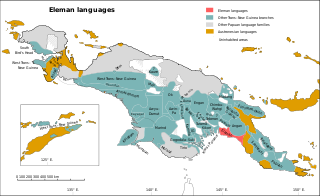Amto–Musan is a language family of two closely related but not mutually intelligible Papuan languages, Amto and Siawi, of Sandaun Province of Papua New Guinea.
The Kwomtari–Fas languages, often referred to ambiguously as Kwomtari, are a dubious language family of six languages spoken by some 4,000 people in the north of Papua New Guinea, near the border with Indonesia. The term "Kwomtari languages" can also refer to one of the established families that makes up this proposal.
The Left May or Arai languages are a small language family of half a dozen closely related but not mutually intelligible languages in the centre of New Guinea, along the left bank of the May River. There are only about 2,000 speakers in all. Foley (2018) classifies them separately as an independent language family.
The Border or Upper Tami languages are an independent family of Papuan languages in Malcolm Ross's version of the Trans–New Guinea proposal.
The Left May – Kwomtari or Arai–Kwomtari languages are a possible small family of Papuan languages proposed by Malcolm Ross, which links the Left May (Arai) family with the Kwomtari–Fas proposal. However, the proposal is problematic; it's not clear if the Arai correspondences are with Kwomtari, with Fas, or with both, as Kwomtari–Fas is itself dubious.
Bayono–Awbono is a recently discovered Papuan language cluster spoken in Papua Province, Indonesia, to the south of the Somahai languages. All that is known of them is a few hundred words recorded in first-contact situations recorded in Wilbrink (2004) and Hischier (2006).
The Yalë language, also known as Nagatman, is spoken in northwestern Papua New Guinea. It may be related to the Kwomtari languages, but Palmer (2018) classifies it as a language isolate.
The Busa language, also known as Odiai (Uriai), is spoken in three hamlets of northwestern Papua New Guinea. There were 244 speakers at the time of the 2000 census. One of the hamlets where Busa is spoken is Busa in Rawei ward, Green River Rural LLG, Sandaun Province.
Nai or Biaka is a language of Papua New Guinea.

The South Bird's Head or South Doberai languages are three families of Papuan languages. They form part of the Trans–New Guinea languages in the classifications of Malcolm Ross (2005) and Timothy Usher (2020), though Pawley and Hammarström (2018) do not consider them to be part of Trans–New Guinea.

The Eleman languages are a family of Papua New Guinea.
The Mindjim languages are a small family of closely related languages spoken in the Mindjim River area of Papua New Guinea. They were linked with the Rai Coast languages in 1951 by Arthur Capell in his Madang family, but separated out again by Timothy Usher.

The Fas languages are a small language family of Papua New Guinea.
Pyu is a language isolate spoken in Papua New Guinea. As of 2000, the language had about 100 speakers. It is spoken in Biake No. 2 village of Biake ward, Green River Rural LLG in Sandaun Province.
Fas is the eponymous language of the small Fas language family of Sandaun Province, Papua New Guinea.
Baibai is one of two Fas languages of Amanab District, Sandaun Province, Papua New Guinea. It is the eponymous language of the spurious Baibai family, which was posited when the Fas language was mistakenly swapped for the Kwomtari language Biaka in published data. It actually has little in common with Kwomtari, but is 40% cognate with Fas.
Kwomtari is the eponymous language of the Kwomtari family of Papua New Guinea.
Guriaso is a language of Papua New Guinea. Only described in 1983, it appears to be distantly related to the Kwomtari and Nai languages. It is spoken in Guriaso ward, Amanab Rural LLG, Sandaun Province.
The Tamolan languages are a small family of clearly related languages spoken in Madang Province, Papua New Guinea:
Manambu is one of the Ndu languages of Sepik River region of northern Papua New Guinea. A Manambu-based pidgin is used with speakers of Kwoma. Manambu has been extensively documented by Alexandra Aikhenvald in a comprehensive grammar.



